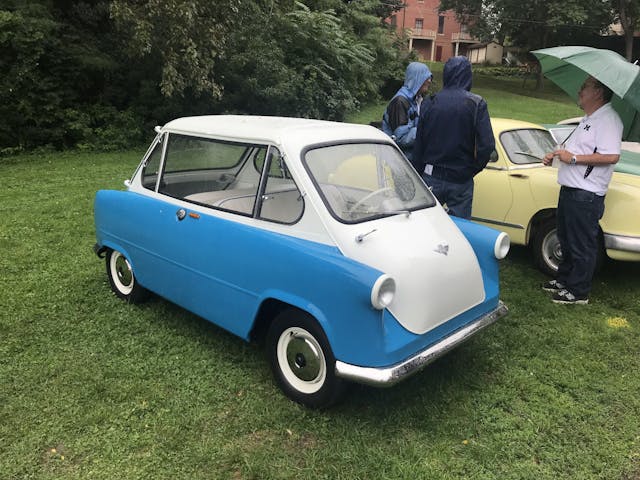How to Give Those Old Windshield Wipers a Fighting Chance
There are few things as frustrating and dangerous as not being able to see the road you are driving on. Our beloved vintage rides do occasionally get caught in the rain, and especially if you are typically a fair weather cruiser in a vehicle that lacks modern wipers, that water can really put a damper on your vision. Luckily there are plenty of modern chemicals designed to help keep water off your windscreen, but do they all work the same, and is there one that works better than the rest?
Glass alone might be plenty smooth, but that does not mean it’s also hydrophobic. Water can still sheet up and cause all kinds of optical problems. Inclement weather often comes with dark skies, bright headlights, and the stress of just trying to survive the thunderdome of the roadways to get your beloved vintage ride home. Windshield wipers have advanced significantly over the years, but retrofitting modern wipers onto vintage cars has yet to catch on, so we are left figuring out other solutions to keep up.
Many years ago I was told that slicing a potato in half and rubbing it on the windshield would help water bead up and slide off. That tricked worked when I got caught in a storm and my motorcycle helmet visor was not shedding water fast enough to keep my vision clear. After that day I came to believe in hydrophobic coatings, the same ones that YouTube channel Project Farm just put to the test to see which is best.
The name recognition of Rain-X is hard to beat, but apparently the function of Rain-X is not nearly as unassailable. Of the nine different coatings tested, several had far better water shedding properties, but also came with finicky multi-step application process. That amount of prep work did seem to correlate with effectiveness when tested with a hose, though two wipes with some windshield washer fluid to simulate cleaning a windshield between storms and suddenly a few proved to be fairly delicate. Even more cleaning with car wash soap of bug and tar remover left all but four still shedding water like new.
Is this perfect real world testing? Not really, but it does give us some insight into a few products that can help us enjoy driving our vintage cars with more visibility. Personally, applying some type of hydrophobic coating to the windshield is part of my pre road trip checklist. Several of the brands across all price points in this test performed admirably, and buyers can make their call based on budget and how much rain their classic is likely to see.
Will these coatings making driving in the rain fun? Maybe not, but it can at least give us a chance at making it home safe and not missing our exit because that sign was just a green blob on the other side of the windshield right up until it wasn’t. Between keeping a windshield clean and using a water repellent like those mentioned in the video above, driving in the rain doesn’t have to be a horrible experience—but cleaning the car afterwards might still be.
And if you were trying to figure out what the car in the feature image is, it’s a 1957 Zundapp Janus. Kudos if you got it right.

***
Check out the Hagerty Media homepage so you don’t miss a single story, or better yet, bookmark it. To get our best stories delivered right to your inbox, subscribe to our newsletters.



kyle, thanx for another article i like.
here’s some things i’ve run across over the years that a lot of you probably already know…
* moderately scrubbing a scotchbrite or similar pad lengthwise while ‘pinching’ the sides of a wiper blade (inserts, or the rubber portion) with soap & water can reduce or eliminate streaks and runs. i can’t say if this holds true with inserts made of a material other than rubber
* i learned much later that cleaning inserts with wd-40, even with a paper towel, also helps with reducing streaking and extending their life
* i’ve used rain-x for a long time. it has always eventually wore off, even if for a fairly long time. i applied it to a windshield immediately after it was replaced – as directed on the bottle. that windshield still beads up fairly well after 7 years
* the cleaner the windshield prior to applying rain-x, the longer the application will last
* when applied per the directions, rain-x did not smear or blur windshield vision on any of my vehicles
* i would drive the same vehicle to the st. louis area and run it through the same sam’s club car wash maybe a half dozen times/year for 4 years. that was 10+ years ago. the windshield still beads up fairly well (the paint some what, too). would be nice to know what treatment(s) they used
* i learned how to look thru the windshield (with rain-x applied) instead of at it while raining. under a number of conditions, i am able to safely view the road without using the wipers. there are conditions i will still use the wipers
i own a 1988 nissan maxima where the inserts are not resting on their edges while in the parked position. the arms would slide on a couple perches, lifting the inserts. the original inserts lasted over 8 years, although in southern california and parked in the garage some of that time. only the passenger side was replaced, the driver side needed replacement a few years later
I’ve had good luck with another product not mentioned — Kleenmaster Brillianize. Works great on plastic (e.g., dashboard instrument lenses) and plexiglass too.